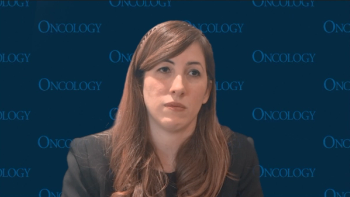
- ONCOLOGY Vol 16 No 1
- Volume 16
- Issue 1
World’s Largest Breast Cancer Treatment Trial Supports Anastrozole Use
New data presented at the recent San Antonio Breast Cancer Symposium demonstrated that anastrozole (Arimidex), as an adjuvant treatment in postmenopausal women with early breast cancer, significantly reduced disease recurrence.
New data presented at the recent San Antonio BreastCancer Symposium demonstrated that anastrozole (Arimidex), as an adjuvanttreatment in postmenopausal women with early breast cancer, significantlyreduced disease recurrence. After a median follow-up of 33.3 months and a medianduration of treatment of 30.7 months, 317 of 3,125 women in the anastrozolegroup relapsed or died, compared with 379 of 3,116 women in the tamoxifen (Nolvadex)group (P = .0129). This represents a 17% reduction in the risk of diseaserecurrence with anastrozole treatment. Among women in the anastrozole group withconfirmed hormone-sensitive tumors, the reduction in risk of recurrence was 22%compared to the tamoxifen group (P = .0054).
The new data are the first results from the ATAC (Arimidex, Tamoxifen Aloneor in Combination) study. The principal US investigator, Aman Buzdar, MD, of TheUniversity of Texas M. D. Anderson Cancer Center in Houston, said the outcomewas important for postmenopausal women with early breast cancer. "Now after20 years, tamoxifen’s established benefits in early breast cancer are beingchallenged," he said. "Tamoxifen is a very effective drug, but it hasside effects, like an increased risk of endometrial cancer, that have to bemanaged. The goal of research in this area is to improve that profile."
Trial Design
The multicenter, randomized, double-blind study involved 9,366 patients from380 cancer centers in 21 countries. Enrollees consisted of early breast cancerpatients who had completed primary surgery and chemotherapy (if given) and werecandidates for adjuvant hormonal therapy. The trial was designed to determine ifanastrozole is equal to, or more effective than, tamoxifen, and whetheranastrozole offers additional safety and tolerability benefits. The study alsoincluded a combination treatment arm (tamoxifen plus anastrozole) to determinewhether taking both medications together was better than taking tamoxifen alone.
Participants were randomized to receive anastrozole (1 mg daily), tamoxifen(20 mg daily), or a combination of the two agents for 5 years or until diseaserecurrence. Primary end points were disease-free survival and safety. Secondaryend points were time to distant recurrence and survival. No additional benefitwas seen with the combination arm over tamoxifen alone. In the combinationgroup, 383 of 3,125 women relapsed or died, compared to 379 of 3,116 of women inthe tamoxifen group.
Adverse Effects Contrasted
Anastrozole was associated with significantly fewer reports of endometrialcancer, thromboembolic events, and vaginal bleeding than tamoxifen. In terms ofadverse events, deep-vein thrombosis was reported in 1.7% of the patients takingtamoxifen compared to 1.0% of the anastrozole recipients. Endometrial canceroccurred at a rate of 0.5% with tamoxifen compared to 0.1% with anastrozole.Vaginal bleeding was reported in 8.1% of tamoxifen patients and 4.5 % ofanastrozole patients. Hot flashes (39.7% vs 34.3%) and weight gain (11.0% vs9.2%) were also more common among women treated with tamoxifen, compared tothose taking anastrozole.
Women taking anastrozole reported less vaginal discharge (2.8% vs 11.4%) andfewer ischemic cerebrovascular events (1% vs 2.1%) than women taking tamoxifen.However, women taking tamoxifen reported fewer musculoskeletal disorders and,specifically, a lower incidence of the types of fractures common in this agegroup, compared to the women taking anastrozole. Fractures (predominantly of thewrist) were reported in 3.7% of tamoxifen patients and 5.8% of anastrozolepatients. The anastrozole/tamoxifen combination treatment group showed noadditional tolerability benefits or issues compared with tamoxifen alone.
Conclusions
The ATAC data will be further analyzed, including subprotocols designedspecifically to investigate the effect of treatment on endometrium, bone, andquality of life. Over the next few years, additional follow-up data will becollected to confirm whether the observed reduction in relapse rates withanastrozole will affect long-term survival.
Articles in this issue
almost 24 years ago
Management of Patients at High Risk for Breast Canceralmost 24 years ago
New Director of the National Cancer Institute Appointedalmost 24 years ago
Enforced Data Collection on Brain Tumorsalmost 24 years ago
Battle Over Physician-Assisted Suicide Continuesalmost 24 years ago
New Treatment for Stomach Cancer Patients Shows Promisealmost 24 years ago
Endoscopic Ultrasound in the Diagnosis and Staging of Pancreatic Canceralmost 24 years ago
Endoscopic Ultrasound in the Diagnosis and Staging of Pancreatic Canceralmost 24 years ago
Endoscopic Ultrasound in the Diagnosis and Staging of Pancreatic Canceralmost 24 years ago
Using Thalidomide in a Patient With Epithelioid Leiomyosarcoma andNewsletter
Stay up to date on recent advances in the multidisciplinary approach to cancer.














































































